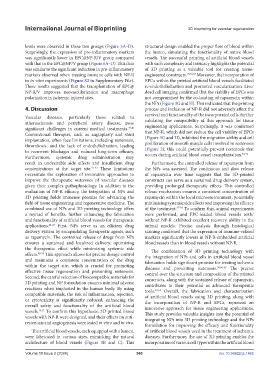Page 368 - IJB-10-2
P. 368
International Journal of Bioprinting 3D bioprinting for vascular regeneration
levels were observed in these two groups (Figure 5A–D). structural design enabled the proper flow of blood within
Surprisingly, the expression of pro-inflammatory markers the lumen, simulating the functionality of native blood
was significantly lower in EPC@NP-R/V group compared vessels. The successful printing of artificial blood vessels
with that in the EPC@NP/V group (Figure 6A–D). This data with such complexity and intricacy highlights the potential
was similar to the significant reduction in pro-inflammatory of 3D printing as a valuable tool for creating tissue-
markers observed when treating immune cells with NP-R engineered constructs. 18,52,53 Moreover, the incorporation of
in in vitro experiments (Figure S2 in Supplementary File). EPCs within the printed artificial blood vessels facilitated
These results suggested that the transplantation of EPC@ re-endothelialization and promoted vascularization. Live/
NP-R/V improves neovascularization and macrophage dead cell imaging confirmed that the viability of EPCs was
polarization in ischemic-injured sites. not compromised by the co-loading of rapamycin within
the NPs (Figure 3G and H). This indicated that the printing
4. Discussion process and inclusion of NP-R did not adversely affect the
survival and functionality of the incorporated cells, further
Vascular diseases, particularly those related to
atherosclerosis and peripheral artery disease, pose validating the compatibility of this approach for tissue
engineering applications. Surprisingly, it was confirmed
significant challenges in current medical treatments. 39,40
Conventional therapies, such as angioplasty and stent that NP-R, which did not reduce the cell viability of EPCs
implantation, often face limitations, including restenosis, (Figure 3G and H), inhibited the migration ability and cell
thrombosis, and the lack of endothelialization, leading proliferation of smooth muscle cells involved in restenosis
to recurrent blockages and reduced long-term efficacy. (Figure 2); this could potentially prevent restenosis that
54-56
Furthermore, systemic drug administration may occurs during artificial blood vessel transplantation.
result in undesirable side effects and insufficient drug Furthermore, the controlled release of rapamycin from
concentrations at the target site. 41-43 These limitations the NPs was assessed. The continuous and slow release
necessitate the exploration of innovative approaches to of rapamycin over time suggests that the 3D-printed
improve the therapeutic outcomes of vascular diseases constructs can serve as a sustained drug delivery system,
given their complex pathophysiology. In addition to the providing prolonged therapeutic effects. This controlled
evaluation of NP-R efficacy, the integration of NPs and release mechanism ensures a consistent concentration of
3D printing holds immense promise for advancing the rapamycin within the local microenvironment, potentially
field of tissue engineering and regenerative medicine. The minimizing systemic side effects and improving the efficacy
combined use of NPs and 3D printing technology offers of the treatment. 57-59 To confirm this, animal experiments
a myriad of benefits, further enhancing the fabrication were performed, and EPC-loaded blood vessels with/
and functionality of artificial blood vessels for therapeutic without NP-R exhibited excellent recovery ability in the
applications. 44-47 First, NPs serve as an efficient drug animal models. Precise analysis through histological
delivery system by encapsulating therapeutic agents, such staining confirmed that the expression of immune-related
as rapamycin. The controlled release of drugs from NPs markers significantly lowers in NP-R-embedded artificial
ensures a sustained and localized delivery, optimizing blood vessels than in blood vessels without NP-R.
the therapeutic effect while minimizing systemic side The combination of 3D printing technology with
effects. 48-50 This approach allows for precise dosage control the integration of NPs and cells in artificial blood vessel
and maintains a consistent concentration of the drug fabrication holds significant promise for treating ischemic
within the target site, which is crucial for promoting diseases and preventing restenosis. 58,60-62 The precise
effective tissue regeneration and preventing restenosis. control over the structure and composition of the printed
Second, the careful selection of biocompatible materials for constructs, along with the sustained release of rapamycin,
3D printing and NP formulation ensures minimal adverse contributes to their potential as advanced therapeutic
reactions when implanted in the human body. By using tools. 63-65 Overall, the fabrication and characterization
compatible materials, the risk of inflammation, rejection, of artificial blood vessels using 3D printing, along with
or cytotoxicity is significantly reduced, enhancing the the incorporation of NP-R and EPCs, represent an
overall safety and functionality of the artificial blood innovative approach for tissue engineering applications.
vessels. 18,51 To confirm this hypothesis, 3D-printed blood This study provides valuable insights into the potential of
vessels with NP-R were designed, and their effects on anti- integrating NPs into 3D printing technology and the NPs
restenosis and angiogenesis were tested in vitro and in vivo.
formulation for improving the efficacy and functionality
The artificial blood vessels, each equipped with a lumen, of artificial blood vessels used in the treatment of ischemic
were fabricated in various sizes, mimicking the natural diseases. Furthermore, the use of 3D printing enables the
architecture of blood vessels (Figure 3B and C). This incorporation of various cell types within the artificial blood
Volume 10 Issue 2 (2024) 360 doi: 10.36922/ijb.1465

